The global desiccated coconut market is projected to grow from USD 8.4 billion in 2025 to USD 15.2 billion by 2035, registering a CAGR of 6.1%.
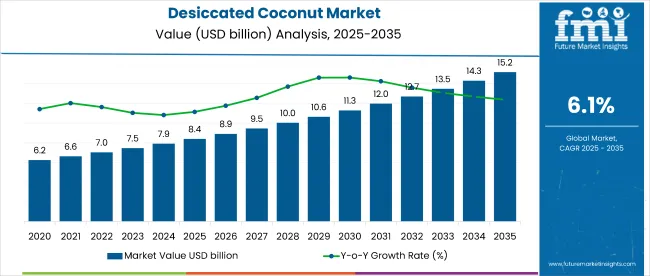
| Metric | Value |
|---|---|
| Industry Size (2025E) | USD 8.4 billion |
| Industry Value (2035F) | USD 15.2 billion |
| CAGR (2025 to 2035) | 6.1% |
The market expansion is being driven by increasing demand for gluten-free, plant-based, and natural food ingredients among health-conscious consumers. Rising application of desiccated coconut in baked goods, confectionery, snacks, and beverages is further supporting global market adoption. Its long shelf life, low moisture content, and high nutritional value make it a preferred choice in both household and industrial food processing sectors.
The market holds an estimated 21% share in the global dried coconut products market, reflecting its strong relevance among processed coconut formats. Within the broader coconut products market, it accounts for around 13%, given the dominance of coconut oil and water. It contributes 4% to the functional food ingredients market and about 2.5% to the organic food market due to rising demand for clean-label products. In the expansive food and beverage ingredients market, its share remains modest at less than 1%, while in the plant-based food market, it represents around 1.2% of total value.
Government regulations impacting the market focus on food safety, organic certification, and quality standards. Regulatory frameworks such as the USDA Organic Certification, EU Organic Regulations (Regulation (EU) 2018/848), and India’s Food Safety and Standards (Organic Foods) Regulations, 2017 promote the production and marketing of clean-label, preservative-free coconut products. These standards drive manufacturers to adopt hygienic, sustainable production practices and invest in product innovation, enhancing global consumer trust and accelerating the adoption of organic desiccated coconut worldwide.
Japan is projected to be the fastest-growing market, expected to expand at a CAGR of 6.4% from 2025 to 2035. Direct will lead the distribution channel segment with a 55% share, while shreds will dominate the form segment with a 34.2% share. The USA and Germany markets are expected to grow steadily at CAGRs of 5.9% and 6.1%, respectively, while the UK and France will expand at CAGRs of 5.7% and 6.1%, respectively.
The is segmented by form, application, distribution channel, and region. By form, the market is categorized into powder, granular, flakes, chips, and shreds. In terms of application, the market is segmented into bakery, confectionery, dairy products, frozen dessert, and other applications (snacks, breakfast cereals, ready-to-eat meals, and sauces).
By distribution channel, the market is bifurcated into direct and indirect (hypermarkets/supermarkets, convenience stores, specialty stores, and online retailers). Regionally, the market is classified into North America, Latin America, Western Europe, Eastern Europe, South Asia & Pacific, East Asia, and the Middle East & Africa.
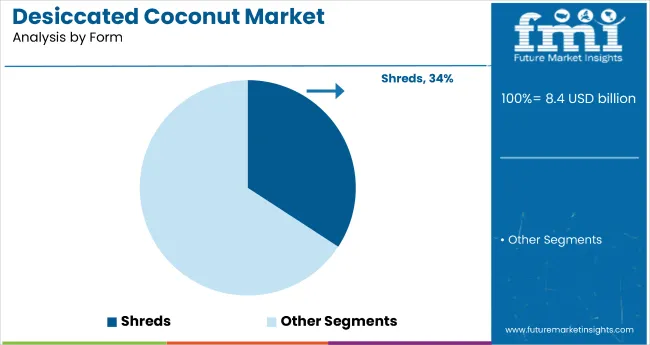
Shreds are expected to lead the form segment with a 34.2% share in 2025, driven by their widespread use in baked goods and sweet dishes across global culinary and food processing industries.
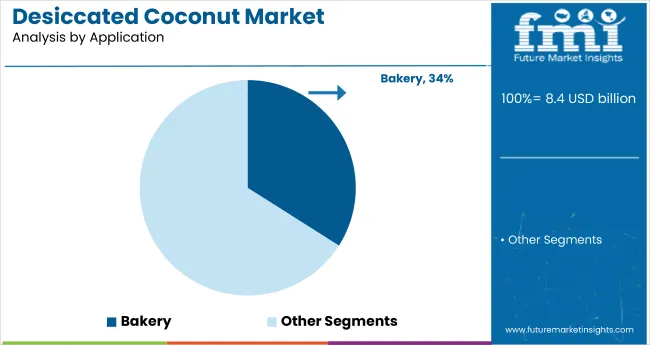
Bakery is expected to dominate the application category in 2025, capturing 34.0% of the global market share due to increasing use of desiccated coconut in cakes, pastries, cookies, and other baked products.
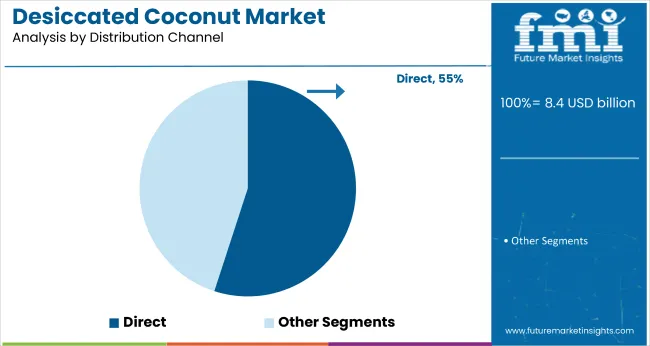
Direct is projected to dominate the distribution channel segment, accounting for 55% of the global market share driven by strong B2B demand and bulk procurement by food manufacturers and institutional buyers.
The global desiccated coconut market is witnessing sustained growth, driven by rising demand from the bakery, confectionery, and dairy industries. Consumers' increasing preference for plant-based, clean-label, and natural ingredients is supporting broader adoption of desiccated coconut across various food segments.
Recent Trends in the Desiccated Coconut Market
Challenges in the Desiccated Coconut Market
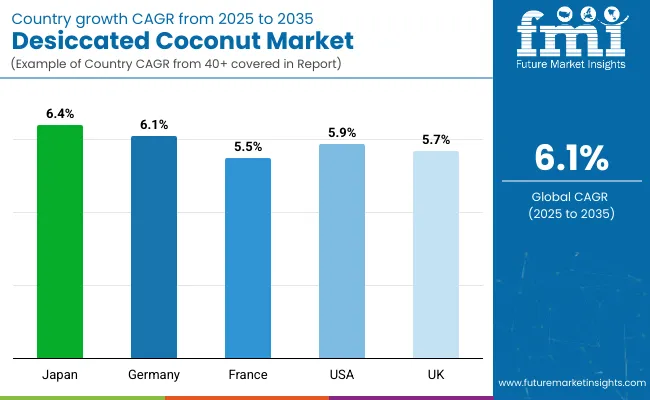
| Countries | CAGR (2025 to 2035) |
|---|---|
| Japan | 6.4% |
| Germany | 6.1% |
| France | 5.5% |
| USA | 5.9% |
| UK | 5.7% |
Japan momentum is driven by rising health consciousness, plant-based diets, and increased consumption of coconut-rich functional foods. Germany and France maintain steady demand driven by the popularity of organic baked goods and strict food safety standards. Developed economies such as the USA (5.9% CAGR), UK (5.7%), and Japan (6.4%) are expected to expand at a stable 0.93-1.05x of the global growth rate.
Japan shows the highest growth among the five countries, supported by strong demand for high-fiber coconut products and organic-certified imports. Germany and France are aligned with the global average, driven by the popularity of clean-label and dairy-free baked goods.
The United States follows with strong demand for keto snacks, protein bars, and plant-based formulations. The United Kingdom sees the slowest growth, shaped by rising vegan preferences and a focus on sustainable sourcing. While Japan is product-innovation led, the USA and UK markets are influenced by lifestyle shifts, and Germany and France benefit from organic retail infrastructure and EU compliance.
The report covers an in-depth analysis of 40+ countries; five top-performing OECD countries are highlighted below.
The Japan desiccated coconut revenue is witnessing a CAGR of 6.4% from 2025 to 2035, fueled by rising demand for high-fiber coconut ingredients in breakfast cereals, healthy snacks, and fusion desserts. The country’s premium food landscape prioritizes imported, organic-certified desiccated coconut, particularly for use in bakery and wellness-focused food items.
The sales of desiccated coconut in Germany are expected to expand at 6.1% CAGR during the forecast period, matching the global average. Demand is driven by the strong presence of organic baking brands and rising consumption of dairy-free alternatives. Coconut is widely used in chocolates, desserts, and wholegrain bread across the country.
The French desiccated coconut market is projected to grow at a 5.5% CAGR during the forecast period, in line with the global trend. Demand is supported by the growing popularity of coconut-based desserts, energy bites, and premium bakery items. France emphasizes clean eating and plant-based indulgence, making desiccated coconut a staple in artisanal patisserie and healthy snacking.
The USA desiccated coconut revenue is projected to grow at a 5.9% CAGR from 2025 to 2035, translating to 0.97x the global rate. Unlike emerging markets focused on base ingredient sourcing, USA demand is driven by value-added health products such as protein bars, keto snacks, and clean-label baking mixes.
The UK desiccated coconut market is projected to grow at a CAGR of 5.7% from 2025 to 2035, representing the slowest growth among the top OECD nations at 0.93 times the global pace. Growth is supported by increasing demand for vegan-friendly, sustainably sourced coconut ingredients in desserts, breakfast cereals, and health snacks.
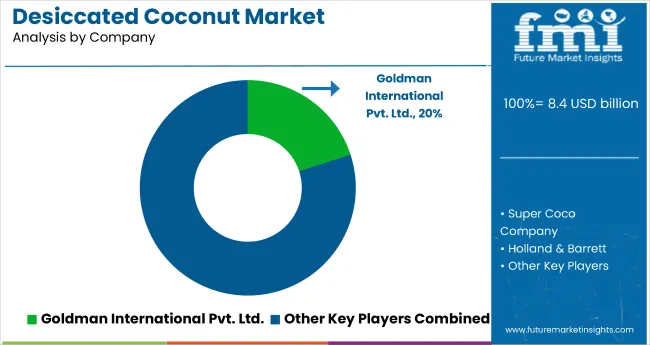
The market is moderately fragmented, with established players such as Goldman International Pvt. Ltd., Super Coco Company, Holland & Barrett, Primex Coco Products Inc., and CBL Natural Foods driving global supply. These companies cater to diverse applications in food processing, bakery, confectionery, and health food industries. Goldman International focuses on high-grade, export-quality coconut ingredients, while Super Coco Company emphasizes supply chain sustainability and organic certification.
Primex Coco Products Inc. and CBL Natural Foods are known for their large-scale production and global distribution capabilities. Holland & Barrett leads in retail distribution with value-added coconut-based health products. Other notable players include S & P Industries SDN. BHD., Pacific Eastern Coconut Utama, VIET DELTA Corporation, Silvermill Group, and Ken Taste Products Limited each offering specialized coconut derivatives to serve regional and international markets.
| Report Attributes | Details |
|---|---|
| Market Size (2025) | USD 8.4 billion |
| Projected Market Size (2035) | USD 15.2 billion |
| CAGR (2025 to 2035) | 6.1% |
| Base Year for Estimation | 2024 |
| Historical Period | 2020 to 2024 |
| Projections Period | 2025 to 2035 |
| Report Parameter | USD billion for value/volume in metric tons |
| Form Analyzed | Powder, Granular, Flakes, Chips, and Shreds |
| Application Analyzed | Bakery, Confectionery, Dairy Products, Frozen Dessert, and Other Applications (Snacks, Breakfast Cereals, Ready-to-Eat Meals, and Sauces) |
| Distribution Channel Analyzed | Direct and Indirect (Hypermarkets/Supermarkets, Convenience Stores, Specialty Stores, and Online Retailers) |
| Regions Covered | North America, Latin America, Western Europe, Eastern Europe, South Asia, East Asia, Middle East & Africa |
| Countries Covered | United States, United Kingdom, Germany, France, Japan, India, Indonesia, Philippines, Brazil, Australia |
| Key Players Influencing the Market | Goldman International Pvt. Ltd., Super Coco Company, Holland & Barrett, Primex Coco Products Inc., CBL Natural Foods, S & P Industries SDN. BHD., Pacific Eastern Coconut Utama, VIET DELTA Corporation, Silvermill Group, Ken Taste Products Limited |
| Additional Attributes | Dollar sales by equipment type, share by power, regional demand growth, policy influence, automation trends, competitive benchmarking |
The market is valued at USD 8.4 billion in 2025.
The market is forecasted to reach USD 15.2 billion by 2035, reflecting a CAGR of 6.1%.
Shreds will lead the form segment, accounting for 34.2% of the global market share in 2025.
Direct will dominate the distribution channel segment with a 55% share in 2025.
Japan is projected to grow at the fastest rate, with a CAGR of 6.4% from 2025 to 2035.






Our Research Products

The "Full Research Suite" delivers actionable market intel, deep dives on markets or technologies, so clients act faster, cut risk, and unlock growth.

The Leaderboard benchmarks and ranks top vendors, classifying them as Established Leaders, Leading Challengers, or Disruptors & Challengers.

Locates where complements amplify value and substitutes erode it, forecasting net impact by horizon

We deliver granular, decision-grade intel: market sizing, 5-year forecasts, pricing, adoption, usage, revenue, and operational KPIs—plus competitor tracking, regulation, and value chains—across 60 countries broadly.

Spot the shifts before they hit your P&L. We track inflection points, adoption curves, pricing moves, and ecosystem plays to show where demand is heading, why it is changing, and what to do next across high-growth markets and disruptive tech

Real-time reads of user behavior. We track shifting priorities, perceptions of today’s and next-gen services, and provider experience, then pace how fast tech moves from trial to adoption, blending buyer, consumer, and channel inputs with social signals (#WhySwitch, #UX).

Partner with our analyst team to build a custom report designed around your business priorities. From analysing market trends to assessing competitors or crafting bespoke datasets, we tailor insights to your needs.
Supplier Intelligence
Discovery & Profiling
Capacity & Footprint
Performance & Risk
Compliance & Governance
Commercial Readiness
Who Supplies Whom
Scorecards & Shortlists
Playbooks & Docs
Category Intelligence
Definition & Scope
Demand & Use Cases
Cost Drivers
Market Structure
Supply Chain Map
Trade & Policy
Operating Norms
Deliverables
Buyer Intelligence
Account Basics
Spend & Scope
Procurement Model
Vendor Requirements
Terms & Policies
Entry Strategy
Pain Points & Triggers
Outputs
Pricing Analysis
Benchmarks
Trends
Should-Cost
Indexation
Landed Cost
Commercial Terms
Deliverables
Brand Analysis
Positioning & Value Prop
Share & Presence
Customer Evidence
Go-to-Market
Digital & Reputation
Compliance & Trust
KPIs & Gaps
Outputs
Full Research Suite comprises of:
Market outlook & trends analysis
Interviews & case studies
Strategic recommendations
Vendor profiles & capabilities analysis
5-year forecasts
8 regions and 60+ country-level data splits
Market segment data splits
12 months of continuous data updates
DELIVERED AS:
PDF EXCEL ONLINE
Coconut Derived Surfactants Market Size and Share Forecast Outlook 2025 to 2035
Coconut Oil Moisturizing Creams Market Analysis - Size, Share, and Forecast Outlook 2025 to 2035
Coconut Water Cosmetics Market Analysis - Size and Share Forecast Outlook 2025 to 2035
Coconut Water-Based Formulas Market Analysis - Size and Share Forecast Outlook 2025 to 2035
Coconut Milk Powder Market Size and Share Forecast Outlook 2025 to 2035
Coconut Water Market Size, Growth, and Forecast 2025 to 2035
Coconut Milk Products Market Trends – Size, Demand & Forecast 2025-2035
Coconut Milk Market Analysis – Size, Share & Forecast Outlook 2025 to 2035
Coconut Butter Market Analysis by End-use Application Sales Channel Through 2025 to 2035
Coconut Sugar Market By Form, Nature, Application and Region - Forecast from 2025 to 2035
Coconut Flour Market Analysis by End-Use, Application, Product Form, Technology, Nature, and Region from 2025 to 2035
Coconut Oil Market Insights - Growing Applications & Industry Expansion 2025 to 2035
Coconut Wraps Market Outlook – Growth, Demand & Forecast 2025 to 2035
Competitive Overview of Coconut Syrup Industry Share
Coconut Cream Market – Growth, Demand & Dairy Alternatives Trends
Coconut-Free Skincare Market Growth – Size, Trends & Forecast 2024-2034
Coconut Fatty Acids Market
Complex Coconut Sugar Market Size and Share Forecast Outlook 2025 to 2035
Analyzing Cooking Coconut Milk Market Share & Industry Leaders
Cooking Coconut Milk Market – Growth, Demand & Culinary Applications

Thank you!
You will receive an email from our Business Development Manager. Please be sure to check your SPAM/JUNK folder too.
Chat With
MaRIA